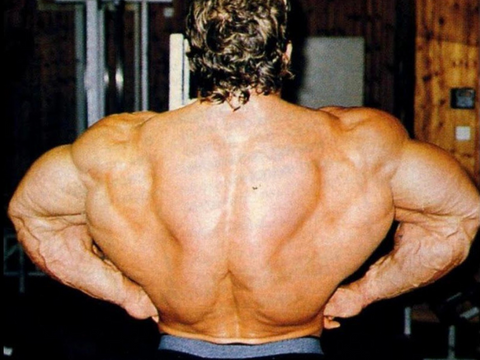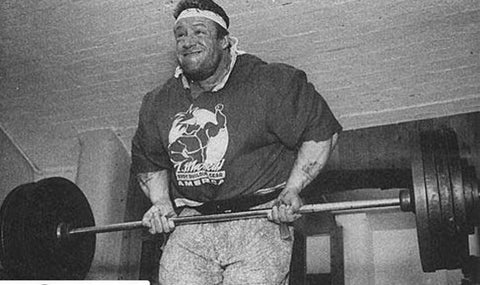How Dorian Yates Built His Back

Throughout my bodybuilding career and even after it, the one question that I still get asked even to this day is, “How did you build your back?!”
If you’re hoping for the ‘big secret’ or ‘special, advanced technique’, then sorry to disappoint, but you won’t find it here!
But if you truly want to understand how I built my back, then read on…


Truth be told, I had good genetics, especially my back. My mum had wide lats, since she rode horses and worked on a farm, so her back was always strong.
So I was genetically gifted, no doubt about it, but I came up against people who had better and thicker backs than myself, such as the late Mohammed Benaziza and Lee Haney.
I remember thinking “Momo’s back was just freaky thick, it was like 3D coming out, it just stuck in my mind. I even put a picture of him on my fridge at home and a picture in the gym! It was awe-inspiring. Funny enough, later on in my career I became known as the guy with the best back!
Even now when I coach people, one of the biggest differences that they immediately see, is an improvement in their back.
So now let’s move onto the exercises themselves and why I chose these particular exercises.
But first, as always, the correct form and tempo is ofcourse important when training any muscle group, but probably more so when training back. This is because, if you don’t follow certain mechanics like, slightly arching the spine, you wont get a full contraction. Also, a lot of people are pulling incorrectly and in turn, are working their biceps more than their backs. To combat this, think of your hands as hooks, then pull with your elbows. Simple, but easy to overlook.
When performing a pulldown, most people think that the wider your hand placement, the wider your lats will be right? Wrong! Looking at the mechanics of the movement, the lats are worked far more when the hands are in a close/medium (shoulder width) grip position.
Okay, now let’s go into my choice of exercises…
To start with, it was the ‘torture device’ that everyone recognises from the Blood & Guts video… the Nautilus Pullover Machine.
I liked to start my back workouts by pre exhausting the lats, and the best exercise to do this was a pullover machine as it did not involve the biceps (like most back exercises do to some extent at least). However, I know that a lot of gyms don’t have a seated pullover machine so a couple of alternative exercises would be to do dumbbell pullovers across a bench, however, it is important to note here that this is half the movement as there is no resistance over the chest. Another option would be to do a standing straight arm pullover on the cable machine.

So after pre exhausting my lats with the Nautilus Pullover Machine, I moved onto pulldowns. This was done with a reverse grip on the Hammer Strength Pulldown Machine that was plate loaded. It is important here to slightly arch the back and squeeze the lats on the contraction. Also, if you can’t hold the weight at the peak contraction for a second, then you didn’t get the rep through pure muscular power and involved additional muscles.

Moving onto next, barbell rows…
Traditional bent-over rows were done with the body parallel to floor and pulling the bar to your chest. My style, which became known as the ‘Yates Row’, are performed with the body being more upright which puts the lower back in a safer position and the lats in a mechanically stronger position. This is great for lat and mid trap thickness and should be a core exercise in your routine!
Another important tip here to fully contract the lats is that the spine should be slightly arched, by keeping your head up, this will help to achieve this.
Either overhand or underhand grip is fine to use here.

To mix things up with this exercise too, I would usually alternate between doing dumbbell rows in replacement for barbell rows on some weeks. This helps to achieve a balanced back.
Next up was either seated cable rows with the grip being around shoulder width, pulling to my abdomen. Or it was Hammer Strength Single Arm Rows, which offer a similar movement to doing dumbbell rows.
Typically, I would do barbell rows followed by the Hammer Strength rows, or dumbbell rows, followed by seated cable rows.

To finish up, it was either hyperextensions or partial deadlifts… "Christmas time, for the lower back!”
I did partial deadlifts last in my back workout because by this point, my back was completely exhausted. I’d use less weight and this increased the stress on my back muscles because as mentioned, it’d be exhausted. I could’ve gone much heavier with this weight if I had did it near the start of my workout, but I’d involve other muscles to assist in lifting the weight. It worked well for me to do it at the end!

So there you have it, those are my favourite exercises that I performed to train my back. As always, the form on these movements needs to be correct and you must pause on the contraction and control the negative portion. If you can’t hold the weight for a second, you used momentum. No throwing or swinging the weights, make the lats do the work.
I kept things rather simple as there is absolutely no need to complicate things!
In terms of reps and sets for using my method of high intensity training, check out our blog dedicated to this topic, Dorian Yates High Intensity Training.
Ready to put in Blood & Guts effort to achieve your physique goals?
I’m ready to take on new, hard working clients now at DY Academy. You’re gonna learn directly from myself and discover my unique methods and mental formulas as well as receiving tailored training & nutrition plans using my 40 years of experience.
Head on over to DY Academy to find out more.
